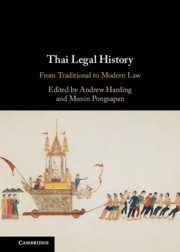Book contents
- Thai Legal History
- Additional material
- Thai Legal History
- Copyright page
- Contents
- Tables
- Contributors
- Preface
- Chronology
- Table of Cases
- Legislation, Constitutional Provisions, and Treaties
- Abbreviations
- 1 Introduction
- 2 Thai Legal History
- Part I Traditional Law and its Modern Resonances
- Part II Foreign Influence and the Reform Period
- 8 British Judges in the Supreme Court of Siam
- 9 The Fundamental Misconception in the Drafting of the Thai Civil and Commercial Code of 1925
- 10 The Modernisation of Thai Criminal Law
- 11 Thai Trust Law
- 12 The History of Thai Family Laws
- 13 The Origins of Thailand’s Bureaucratic State and the Consolidation of Administrative Justice
- 14 Siam and the Standard of Civilisation in the Nineteenth Century
- Part III Constitutional Conflicts 1932–2017
- Glossary
- Index
9 - The Fundamental Misconception in the Drafting of the Thai Civil and Commercial Code of 1925
from Part II - Foreign Influence and the Reform Period
Published online by Cambridge University Press: 28 May 2021
- Thai Legal History
- Additional material
- Thai Legal History
- Copyright page
- Contents
- Tables
- Contributors
- Preface
- Chronology
- Table of Cases
- Legislation, Constitutional Provisions, and Treaties
- Abbreviations
- 1 Introduction
- 2 Thai Legal History
- Part I Traditional Law and its Modern Resonances
- Part II Foreign Influence and the Reform Period
- 8 British Judges in the Supreme Court of Siam
- 9 The Fundamental Misconception in the Drafting of the Thai Civil and Commercial Code of 1925
- 10 The Modernisation of Thai Criminal Law
- 11 Thai Trust Law
- 12 The History of Thai Family Laws
- 13 The Origins of Thailand’s Bureaucratic State and the Consolidation of Administrative Justice
- 14 Siam and the Standard of Civilisation in the Nineteenth Century
- Part III Constitutional Conflicts 1932–2017
- Glossary
- Index
Summary
The work of codification of civil and commercial law, which began in 1908 under the direction of French draftsmen, produced the desired result in 1925 only after Phraya Manavarajasevi (Plod na Songkhla) became involved. Plod was instrumental in replacing the French Civil Code of 1804 with the German Civil Code of 1900 (“BGB”) as the principal model and introducing the Japanese Civil Code of 1898 (“JCC”) and a copying method which he referred to as the ‘Japanese method’ to the new Thai-dominated drafting committee. The JCC and the ‘Japanese method’ were chosen owing to Plod’s conviction that the Japanese had established their civil code by copying the BGB. In reality, the JCC was influenced by a variety of foreign laws, including German and French law. The drafting committee’s lack of knowledge about the rules and concepts they borrowed and the method they adopted led to difficulties in interpreting the rules and concepts in question. This chapter will explore Plod’s fundamental misconception in the drafting of the TCCC and its consequences with a particular focus on the principle of fault in breach of contract.
Keywords
- Type
- Chapter
- Information
- Thai Legal HistoryFrom Traditional to Modern Law, pp. 122 - 137Publisher: Cambridge University PressPrint publication year: 2021
- 1
- Cited by

